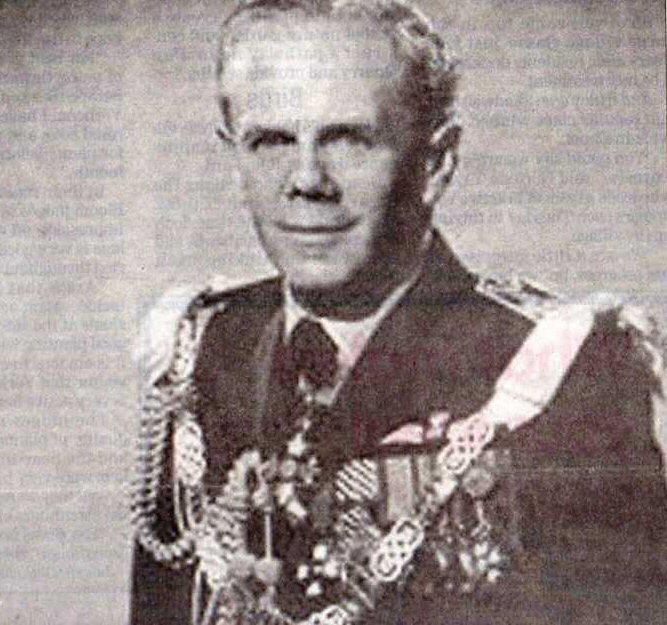|
An extraordinary house, an extraordinary hero.
ON December 8 1942 Lancaster bombers under the command of Group Captain Augustus Walker were preparing to take off on a night raid over Turin. All were fully armed, many with l,000lb bombs, and fuelled for the punishing raid over Italy.
While taxiing to take off, Gp Capt Walker saw something fall from the bomb bay of one of the heavy bombers and, thinking it might have been a bomb, instinctively rushed across the airfield to warn the crew to abandon the sortie. bombers and, thinking it might have been a bomb, instinctively rushed across the airfield to warn the crew to abandon the sortie.
Suddenly there was an explosion. He was within a few metres of the aircraft and was thrown nearly 80 metres by the blast, severing his right arm. Incredibly, as he was being taken to hospital he asked one of his staff to telephone the RAF top brass to ask if they would take back a one-armed station commander in two month's time. Two months later, he was back on duty.
Only a month after that he became an Air Commodore at the age of 30 and continued to lly. having an artificial arm with leather loops which he wrapped around the control column. During his 36-year RAF career he rose be Air Chief Marshall and ultimately became a deputy Commander-in-chief of Nato.
Blue plaque
Now Sir "Gus" Walker, will be remembered when a blue plaque is placed on his childhood home in the then mining village of Garforth, near Leeds, on October 11. The plaque in Lidgett Lane will be provided by Garforth Historical Society supported by Leeds Civic Trust.
Born in 1912. Walker won a place at Cambridge University and joined the RAF in 1934, when it was becoming clear that air power would be decisive in future conflicts. He was already a squadron leader when the Second World War broke out in 1939.
Soon he was appointed Wing Commander and took command of 50 Squadron at Lindholme, South Yorkshire, flying Lancaster bombers. He took part in the famous bombings of the German battleships Scharn/wrst and Gneisenau in July 1941 and was awarded the Distinguished Service Order (DSO) and Distinguished Flying Cross (DFC). He was then promoted to Group Captain and appointed to command RAF North Luffenham in Rutland.
In 1954, he became Commandant of the RAF's flying college at Manby in Lincolnshire, where he learned to fly jets. Later on in he learned to fly helicopters as an Air Vice-Marshall, going solo after just five days. in he learned to fly helicopters as an Air Vice-Marshall, going solo after just five days.
In 1964 Air Marshall Sir Augustus Walker became the Inspector General of the RAF and finally Air Chief Marshall in 1967, when he accepted the Nato appointment of Deputy Commander-in-Chief Allied Forces in Europe.
He made his last flying log entry in 1970 when he retired aged 57. In retirement "Sir Gus" took up a wide range of interests including being one of the first patrons of the Yorkshire Air Museum at Elvington. Ron Sudderdean, from the Garforth Historical Society said: "Sir Gus died in December 1986 aged 74 and since that time we have pondered how best to remember such a great man. "The entire funds for the plaque and ceremony supporting the unveiling were raised by the Garforth Historical Society which wanted to celebrate one of its sons who became a war hero, received horrific injuries and then rose to thehighest ranks within the Roya! Air Force. We raised the £600 needed mainly through sales of books we wrote about Garforth's history. It's money well spent." The director of Leeds Civic Trust, Dr Kevin Grady, said; "From time to time we receive requests from individuals and organisations for a civic plaque. The Garforth Historical Society is so proud of'Sir Gus' that they have allocated all their funds this year for the project.
"The plaque will be sited on the route large numbers of students take to their local college. It will be an inspiration to them."
The plaque will be unveiled by Linton on Ouse Station Commander Group Captain Andy Sudlow. It will read: "Air Chief Marshal Sir Augustus Walker was born in Garforth and brought up in this house. Serving in the RAF he rose to its highest ranks. An inspirational figure, he led during raids with 50 Sqn on industrial targets in Germany and commanded a series of bomber stations during World War Two."
The plaque will be sited on the route large numbers of students take to their local college. It will be an inspiration to them.
|

